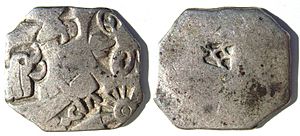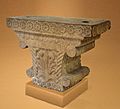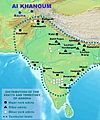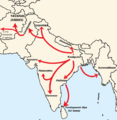Maurya Empire facts for kids
Quick facts for kids
Maurya Empire
|
|||||||||||||||||
|---|---|---|---|---|---|---|---|---|---|---|---|---|---|---|---|---|---|
| 322 BCE–185 BCE | |||||||||||||||||
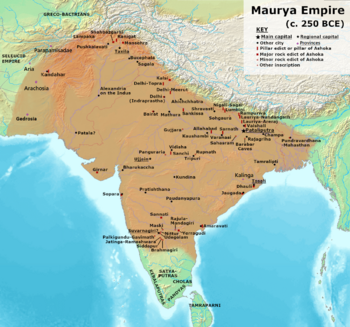
Maurya Empire at its maximum extent
|
|||||||||||||||||
| Capital | Pataliputra (Present-day Patna) | ||||||||||||||||
| Common languages | Old Indic Languages (e.g. Magadhi Prakrit, Other Prakrits) | ||||||||||||||||
| Religion | Brahmanism Buddhism Jainism Ājīvika |
||||||||||||||||
| Government | Absolute monarchy as described in the Arthashastra | ||||||||||||||||
| Emperor | |||||||||||||||||
|
• 320–298 BCE
|
Chandragupta | ||||||||||||||||
|
• 298–272 BCE
|
Bindusara | ||||||||||||||||
|
• 268–232 BCE
|
Ashoka | ||||||||||||||||
| Historical era | Antiquity | ||||||||||||||||
|
• Established
|
322 BCE | ||||||||||||||||
|
• Disestablished
|
185 BCE | ||||||||||||||||
| Area | |||||||||||||||||
| 5,000,000 km2 (1,900,000 sq mi) | |||||||||||||||||
| Currency | Panas | ||||||||||||||||
|
|||||||||||||||||
| Today part of | |||||||||||||||||
The Maurya Empire was the first really big empire in ancient India. It was started in 322 BCE by a powerful leader named Chandragupta Maurya. This empire was important because it united many different kingdoms across a huge area.
Contents
The Maurya Empire: A Great Ancient Kingdom
The Maurya Empire was one of the largest empires in the world during its time. It stretched across most of the Indian subcontinent. This empire lasted for about 137 years, from 322 BCE to 185 BCE.
Chandragupta Maurya: The Founder
Chandragupta Maurya was the brave leader who founded the Maurya Empire. He took over the Nanda dynasty with the help of his advisor, Chanakya. Chanakya was a very smart thinker and strategist.
By 316 BCE, Chandragupta had taken control of the northwestern parts of India. He defeated the governors who were left behind by Alexander the Great. Chandragupta also defeated Seleucus I Nicator, a Greek general. This victory helped him gain even more land beyond the Indus River.
Bindusara: The Slayer of Enemies
After Chandragupta Maurya, his son Bindusara became the emperor in 298 BCE. Bindusara was known as "Amitraghata," which is a sanskrit word meaning "slayer of enemies." He continued to expand the empire.
Bindusara conquered many southern parts of India. By the time he died, almost all of India was part of the Maurya Empire. Only a small region called Kalinga (which is now Odisha) and some parts of Tamil Nadu remained unconquered.
King Ashoka: A Change of Heart
King Ashoka, Bindusara's son, became emperor in 268 BCE. He is known as one of the greatest emperors in the history of the Indian subcontinent. Ashoka wanted to conquer Kalinga, the last unconquered region.
He fought a very violent and bloody war known as the Kalinga War. More than 200,000 people were killed or hurt in this war. The region of Kalinga was completely destroyed. Seeing all this bloodshed deeply changed Ashoka.
After the Kalinga War, Ashoka felt terrible about the violence. He decided to change his life and follow the path of peace. He became a Buddhist and spent the rest of his life promoting ahimsa (non-violence) and dharma-vijaya (victory through righteousness).
King Ashoka built many Rock Edicts and Stupas across his empire. These were pillars and monuments with messages about peace and good behavior. The national emblem of India today comes from one of his famous pillars. Because of his wisdom and peaceful rule, he became known as Ashoka the Great.
Decline of the Empire
After King Ashoka died in 232 BCE, the Maurya Empire began to weaken. The empire only lasted about fifty more years after his death. The last Mauryan emperor was Brihadratha Maurya.
In 185 BCE, Brihadratha Maurya was killed by his own general, Pushyamitra Shunga. Pushyamitra Shunga then started a new kingdom called the Shunga Empire. This marked the end of the great Maurya Empire.
Images for kids
-
Pataliputra, the capital city of the Mauryas. These are the ruins of a pillared hall at the Kumrahar site.
-
A silver coin (1 karshapana) from the Maurya Empire, during the time of Bindusara Maurya (about 297–272 BCE). It was made in Pataliputra.
-
The famous Lion Capital of Ashoka found at Sarnath, from around 250 BCE.
-
An Ashoka pillar located in Vaishali.
-
A piece of the 6th Pillar Edict of Ashoka (238 BCE), written in Brahmi on sandstone, now in the British Museum.
-
Bhadrabahu Cave, Shravanabelagola, where Chandragupta is believed to have died.
-
The stupa at Sanchi was first built by the Maurya Empire. It held relics of Buddha.
-
An early stupa, 6 meters wide, with a fallen umbrella on its side. Found in Chakpat, near Chakdara. Likely Maurya, 3rd century BCE.
-
A figure of a foreigner, found in Sarnath, from the 3rd century BCE.
-
A map showing where the Edicts of Ashoka were found.
-
A map showing the Buddhist missions during the reign of Ashoka.
See also
 In Spanish: Imperio Maurya para niños
In Spanish: Imperio Maurya para niños


